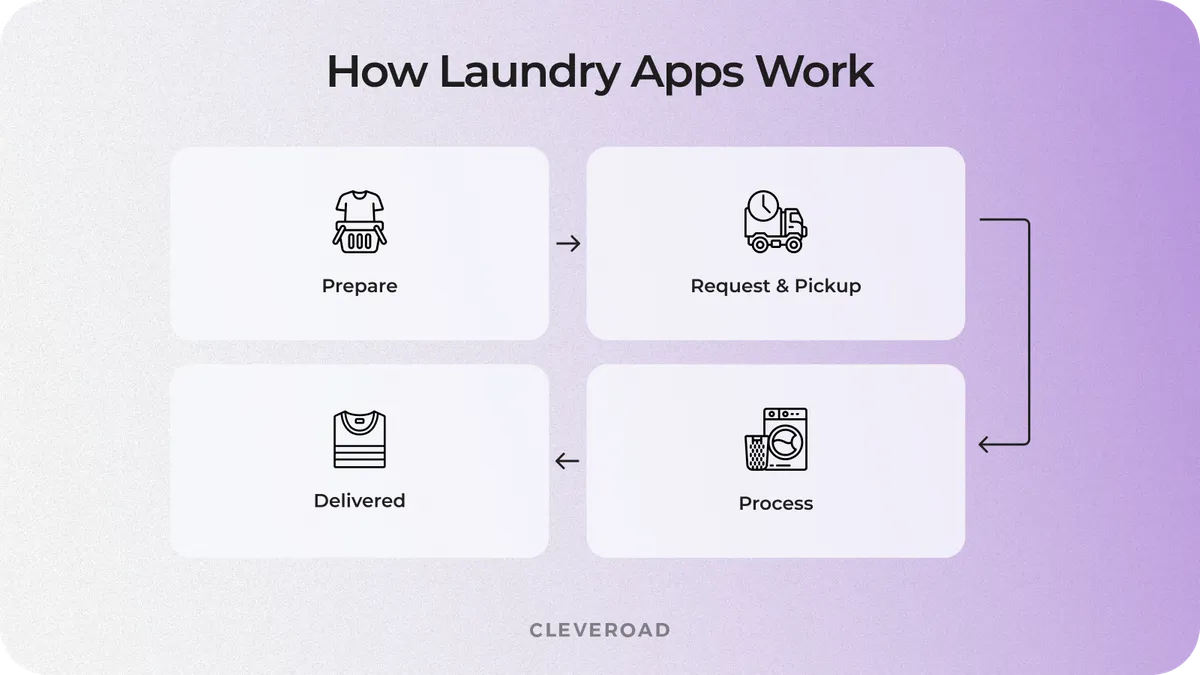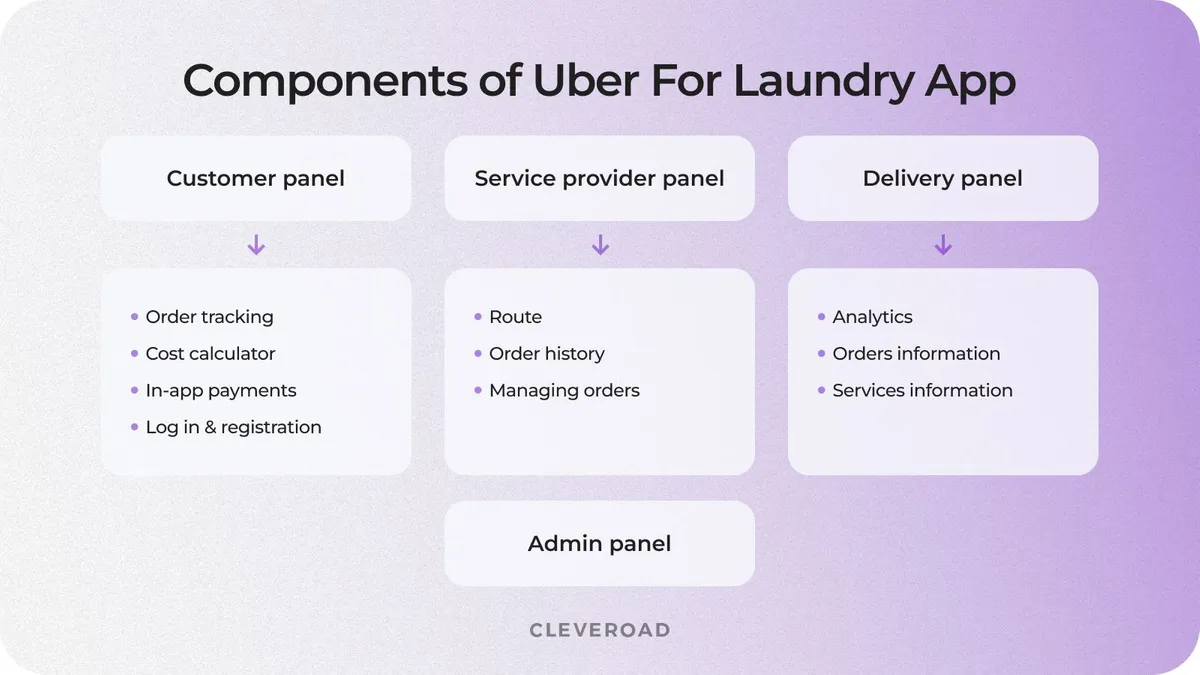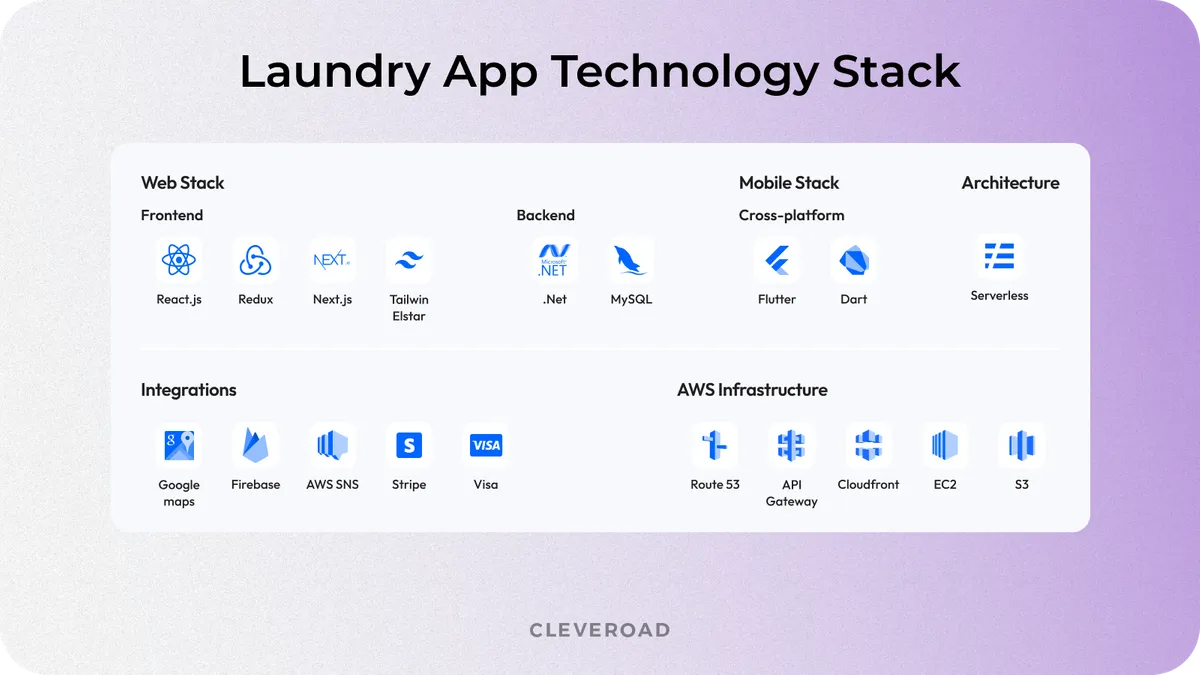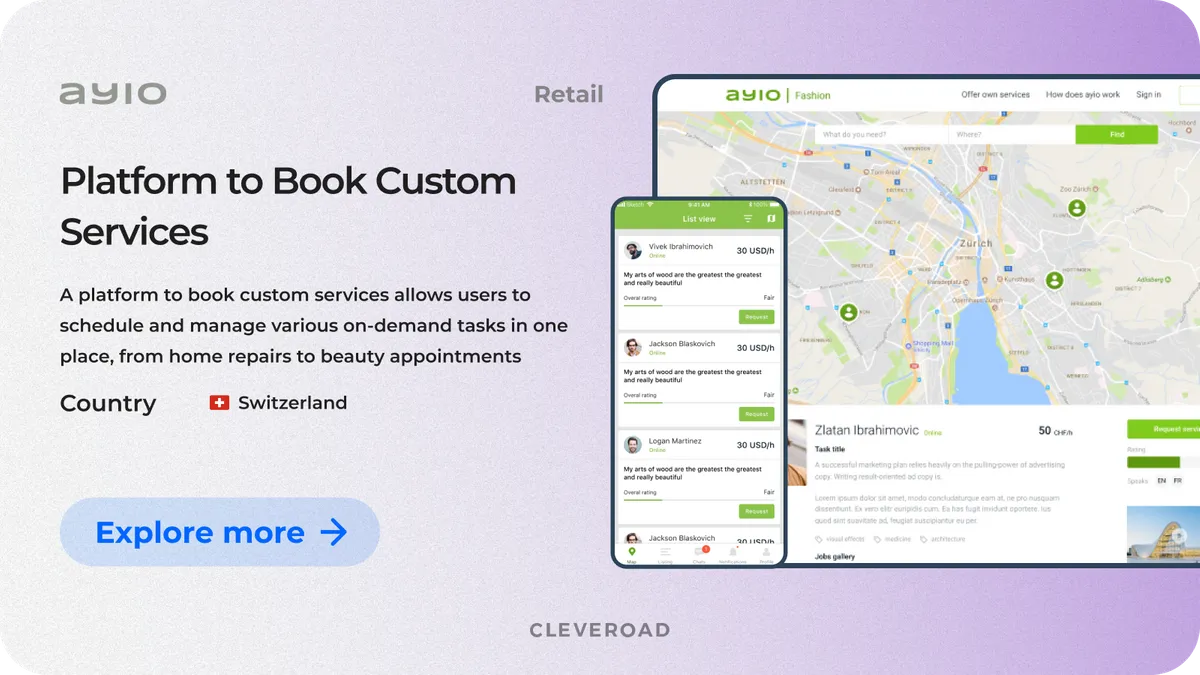Laundry App Development in 2026: All Benefits and Obstacles
Updated 30 Sep 2025
17 Min
8732 Views
Laundry mobile app development comes in handy to make accomplishing small tasks easier and simplify household chores. When it comes to accomplishing small tasks, on-demand services come in handy. You can order pizza in a few clicks, find a babysitter through a mobile app, and, yeah, get dirty clothing cleaned and ironed with a couple of taps with laundry app services.
We at Cleveroad have delivered 200+ custom apps, including on-demand platforms with scheduling, payments, and more. Based on our experience, we’ll show you how to build a laundry app that meets customer expectations and helps your business grow. In this guide, you’ll learn:
- What an on-demand laundry app is and how it works, from placing an order to getting clothes delivered back clean and ready to wear
- Why the “Uber for laundry” model is popular, with benefits like time-saving convenience, flexible scheduling, and transparent service
- Which core features make a laundry app successful, including booking options, in-app payments, tracking, and analytics
- How different monetization models work, comparing marketplace apps that connect users with shops to on-site apps that scale your own business
- What factors affect laundry app development cost, such as region and feature complexity
- How to pick the right tech partner, and why proven experience in on-demand laundry solutions matters for long-term success
What Is On-Demand Laundry App
An on-demand laundry app is a digital platform that connects users with laundry and dry-cleaning services in a fast and convenient way. With just a few taps, customers can book a pickup, calculate service costs, make payments, and leave feedback without visiting a physical shop.
Laundry mobile app development involves creating applications that streamline laundry services, offering features like online ordering, scheduling, and real-time tracking. These apps benefit both customers and laundry businesses by increasing convenience and improving efficiency.
For laundry business owners, such apps also automate key processes, from order booking and payments to pickup and delivery logistics, allowing them to scale operations, attract more customers, and deliver a better overall experience.
How laundry apps work
Online laundry apps follow a simple four-step process designed to make the entire experience fast:
- Prepare. The user gathers clothes that need washing, dry cleaning, or ironing and places them in a bag ready for pickup.
- Request & pickup. Through the app, the customer schedules a pickup time that fits their routine. A delivery person then arrives to collect the laundry and transport it to the laundry service provider.
- Process. At the laundry facility, clothes go through the requested services such as washing, drying, ironing, or dry cleaning. Service providers update the order status in real time, so customers can track progress through the app.
- Delivered. Once everything is ready, the clean clothes are delivered back to the customer’s address at the scheduled time, neatly packed and ready to use.

How laundry apps work
Most laundry apps also support flexible payment methods. Customers can either pay online once the order is completed or upon delivery, depending on the business model. Real-time notifications keep users informed at every step, ensuring transparency and trust.
Must-Have Features for On-Demand Laundry App Development
After examining the mechanism of operation of laundry apps, let’s explore common features for this type of application. If you are considering using an on-demand laundry app development services, this paragraph is essential and can help you estimate development costs. To create a laundry app, you should consider that Uber for laundry apps usually consists of several solutions.

Components of Uber for laundry app
Customer panel
A laundry app development service includes a customer panel consisting of the login form and customer data with all needed information (i.e., customer address, first name, etc.). With the help of this panel, clients can calculate costs and make and track their orders. Basic features of a laundry service app for the customer panel can be the following:
Cost calculator
Laundry app development solution lets your customers choose the type of clothes and, according to this information, can view how much a laundry process or dry-cleaning service will cost them.
Multiple booking options
You should make it possible for clients to make bookings according to their requirements. Usually, customers have two options: book now or later. It’s a useful user feature since they can plan the requests by pointing to the date and time.
Cancel bookings
Users always appreciate the opportunity to cancel their requests in case of an emergency. Some service providers enable clients to cancel their orders via a mobile app. Once they cancel the request, service providers get a notification and change their schedule accordingly.
In-app payments
Cash-free payment is an effortless way to pay for services. This feature allows users to pay for services with a few taps.
Learn how to integrate payment gateway in mobile application by reading our guide
Push notifications and order tracking
Most users want to be sure everything is okay with their clothes. The application notifies customers whether their clothes are washed, if some problems have occurred, or if payment was successful. Real-time tracking lets users monitor the service provider’s journey utilizing Google Maps.
Schedule pickups and order history
With scheduled pickups, customers can choose the most convenient time for them. Order history allows them to view previous orders and repeat them.
View and rate laundries
The service connects users to nearby laundrymen who can take the clothes. Customers can enter the dry cleaners’ profile and check the number of completed orders, client feedback, and ratings. The quick-search bar allows users to find the right match for themselves, which improves their experience.
Invoice generation
After the customers pay for the services, the invoice is generated automatically within the app. It displays information about clients’ names/surnames, locations, types of services, and payment methods. Besides, customers can save the invoice for future purposes.
| Customer panel features | Development time (h) |
Registration | 67 hours |
Login | 38 hours |
Subscriptions | 43 hours |
Order Laundry Service | 63 hours |
Orders & Stuff Management | 126 hours |
Store | 161 hours |
Profile | 179 hours |
Total development time | 677 hours |
Delivery panel
This panel is useful for managing order delivery. It enables delivery men to process requests and choose optimized routes. However, if you select the marketplace business model, you can save some money, as there is no need for this feature. Here are basic features for delivery panel:
Order history
With the help of this feature, delivery men can get info about orders waiting for approval and the time when he/she must pick them up. He can accept or decline the order by his/her availability.
Routing
Depending on orders, the delivery man builds the best route from customers to the laundry and dry-cleaning shop and vice versa.
Managing orders
After getting the notification, the delivery man sets the status of the order at the time when the laundry is picked up, washed, and delivered.
| Delivery panel features | Development time (h) |
Login | 11 hours |
Report | 19 hours |
Delivery from Gym | 83 hours |
Delivery to Gym | 41 hours |
Delivery from Laundry | 28 hours |
Deliver to Laundry | 31 hours |
Total development time | 213 hours |
Service provider panel
The service provider panel is essential for the laundry apps to manage and streamline operations because it allows them to update service details and monitor the performance of their businesses in the laundry sector. But, in case your mobile laundry business uses an on-site model, there’s no need to develop a service provider model. Let's look at the features service provider panel must have:
Information about an order
With this feature, a service business provider can accept or decline orders and view the information about the order (i.e., the customer's preferences).
Manage information about services
This feature allows owners to easily update price lists, special offerings, working hours, promotional events, available discounts, etc.
View analytics
Laundry shops can view their income, the number of orders per month, average order size, repeat customer rate, monthly growth trends, etc.
Add services
Providers can add services by filling out the required data (service type, rates, and other related information). This feature will allow them to get extra money, and it’ll also be helpful for customers to get services done from one provider.
Master reports
Admin can create various reports using one specific feature (number of orders, driver’s order history, total income, etc.). These reports will allow managers to make informed financial decisions.
| Service provider panel features | Development time (h) |
Login | 10 hours |
Subscriptions Management | 57 hours |
Shelves Management | 38 hours |
Orders & Stuff Management with Customer | 61 hours |
Orders & Stuff Management with Driver | 69 hours |
Report | 15 hours |
Total development time | 250 hours |
Laundry app development services need an admin panel that manages interactions between all panels and stores and analyzes data. In order to realize an efficient and scalable admin panel, you need to choose the right cloud technology. We at Cleveroad, as an AWS Select Tier partner, can help select a reliable cloud server for your laundry application.
Laundry Application Development Steps
Building a laundry app is about research, planning, smart execution, and more. Below are the key steps to create an on-demand laundry app solution that attracts customers and supports business growth.
Step 1. Conduct market research
Laundry service market research is the foundation of any successful development. At this stage, you need to analyze the demand for on-demand laundry services in your region, identify your target audience, and assess your competitors. Examine the features and services offered by top laundry apps like Rinse or Cleanly, and identify their strengths and weaknesses. This helps you understand which features users expect as a baseline and where you can differentiate, for example, eco-friendly detergents, faster delivery, or loyalty programs.
As part of our Discovery Phase services, we’ll turn market insights and your input into a detailed development plan covering features and scope to ensure a smooth and efficient start to your project
Step 2. Select your laundry app monetization strategy
Your monetization model determines how you generate revenue and how users and partners will interact with your app. So, pick a model that helps you take your laundry business online with clear margins. There are two proven monetization approaches in the laundry domain:
- Marketplace model. Your app becomes a platform that connects customers with nearby laundries. Users can compare providers, place orders, and leave reviews, while you take a commission from each transaction. This model works well for startups with limited resources because it doesn’t require owning laundry facilities. Instead, you focus on building partnerships with local vendors.
- On-site model. If you already run a laundry shop, the app becomes an extension of your existing business. Customers can schedule pickups and deliveries directly, while you earn from each order. This approach helps scale operations, increase loyalty, and attract new clients who prefer the convenience of mobile ordering.
Some apps also experiment with hybrid strategies, such as adding premium delivery (express turnaround for an extra fee) or subscription packages for frequent users. Choosing the right monetization model early is crucial, as it shapes your app’s features, pricing strategy, and required logistics setup.
Step 3. Find a reliable laundry app development partner
Since the laundry dry cleaning app development is quite technically complex and has many features, we recommend that you look at the outsourcing market and find a reliable laundry mobile app development company.
There are a lot of laundry software providers worldwide, and you are sure to find a team that can meet your needs. Here are key factors you should pay attention to when choosing laundry app developers:
- Technical expertise. The vendor should have strong experience in mobile and web development, API integrations, data security, and building scalable architectures.
- Skills in creating similar solutions. Choose a vendor that knows how to develop stable, user-friendly on-demand platforms with features like booking, tracking, and real-time notifications.
- Portfolio cases. Make sure the company can show proven success through case studies of similar on-demand or service-based apps that delivered measurable results.
- Client testimonials. Customers’ reviews will also show the vendor’s quality of service. Look at our Clutch page to see our clients’ reviews.
- Sufficient talent base. You should make sure the company has a considerable pool of experts in on-demand app development.
Cleveroad has extensive experience in providing custom software development services for SMBs and startups. To prove our expertise, we’ll show you our recent case.
Cleveroad partnered with DGTL Ventures, a Swiss consultancy working with enterprise clients like BMW and AXA, to build Hairdressers – the first digital platform in Switzerland connecting freelance hairdressers with salons offering chair rentals. We conducted a Solution Design Workshop, then developed a secure and scalable MVP with intuitive UI/UX, an admin portal, and a full DevOps setup. The platform followed the Uber-for-X model, launched on time, and exceeded client expectations in cost optimization and performance.
As a result, our client received a secure and well-structured MVP of a hairdresser chair-booking platform that matched all requirements, followed the Uber-for-X model, and met the launch deadlines.
Here is what Gilles Fransen, CEO of DGTL Ventures, says about collaboration with Cleveroad:
Gilles Fransen, CEO of DGTL Ventures: Testimonial on Cleveroad's Software Development Expertise
Step 4. Decide on features and app architecture
When you’ve found the vendor, the next step is to define what functionality your laundry app should include and how it will be built. Start by listing the must-have features for customers (easy booking, in-app payments, push notifications, real-time order tracking), delivery staff (laundry management and routing), and service providers (analytics dashboards, price management). Adding optional features like loyalty programs, eco-friendly washing preferences, or subscription plans can further differentiate your app and increase retention.
Equally important is the selection of the tech stack. It is the set of programming languages, frameworks, and cloud services that will power your app. The right stack directly influences scalability, performance, and integration with third-party tools like payment gateways or mapping services.
Below, you can see the tech stack that Cleveroad’s team uses for laundry app development.

The technology stack that the Cleveroad team uses during software development
Step 5. Design user-friendly UI/UX
For a laundry service app, design directly impacts whether users return to your app after the first try. A laundry application must make every action, from booking to payment, as intuitive and fast as possible (Source: Indo-JC). Customers expect to place an order in just a few taps, receive clear status updates, and track their laundry without confusion. If navigation is complex or screens feel overloaded, they’ll abandon the app and switch to a competitor.
A strong UI/UX design combines simplicity with trust. Clear icons, readable typography, and consistent colors make the interface comfortable, while transparent flows (for example, showing the order stage: picked up → processing → ready → delivered) build confidence. It’s also essential to think about accessibility, such as large buttons and logical tab placement, to make the app easy to use.
Step 6. Laundry mobile app development
At this stage, your laundry app moves from planning to reality. Development is usually carried out in Agile sprints, where the team builds and delivers features step by step. Laundry app development process covers both the front-end (interfaces customers, couriers, and providers interact with) and the back-end (servers, APIs, and databases that handle orders, payments, and notifications). This structure makes the app responsive for users while ensuring secure data handling and seamless performance on the technical side.
At Cleveroad, testing is an integral part of the development process. After each sprint, our QA engineers check new functionality, while regression testing ensures that updates don’t break existing features. Usability checks help confirm that flows like booking, tracking, and payments remain simple and intuitive. Regular demo sessions with the development team let you review progress, provide feedback early, and keep the product aligned with your business needs. By the end of this stage, you’ll have a fully tested and stable laundry app ready for release.
Step 7. Launch and further support
When development and testing are complete, the laundry app is ready to go live. The team prepares all technical documentation, submits the app to the App Store and Google Play, and configures servers for stable performance. This stage also includes setting up analytics tools so you can track downloads, user activity, and engagement from day one. A smooth launch builds trust with early users and sets the foundation for scaling your service.
However, on-demand services evolve rapidly, and user expectations change just as quickly. To stay competitive, your app will require ongoing updates, including bug fixes and performance improvements. Continuous support ensures your app runs smoothly, adapts to new OS versions, and grows together with your business goals. At Cleveroad, we treat post-launch support as a long-term partnership, helping clients refine their apps based on real user feedback.
Benefits of Laundry App Development
Laundry app development brings tangible advantages for both customers and service providers. These apps transform from saving time to cutting costs and boosting loyalty.
Increased convenience
Laundry delivery app development lets you provide your customers with scheduled pickups and deliveries from anywhere at any time, turning laundry into a simple on-demand task. This is why 60% of consumers say they use on-demand services primarily for convenience (Source: Appnext). By reducing the need for store visits or phone calls, apps make laundry as easy as ordering food or booking a ride.
Improved efficiency
Digital tools automate orders, optimize delivery routes, and streamline communication between clients and providers. An app like Cleanly, a well-known laundry startup, can use automation to cut turnaround times to just 24 hours (Source: PR Newswire). These efficiency gains help providers handle more orders without increasing resources.
Reduced operational costs
Optimized logistics and reduced reliance on storefronts lowers daily expenses for laundry businesses. According to laundry industry research, digital scheduling and route optimization can significantly lower operational costs (Source: PR Newswire). Less fuel waste, fewer manual errors, and smaller staffing needs translate into higher profit margins.
Expanded customer reach
Mobile apps expand visibility beyond local foot traffic, enabling businesses to engage with customers across larger areas. Unlike websites that often attract one-time visitors, apps stay on users’ phones, encouraging repeat use through push notifications and loyalty programs. In fact, the Retail Insight Network survey shows 64% of consumers say they prefer using a business’s mobile app over its website via browser, showing how apps drive ongoing engagement and expand customer reach.
Enhanced customer experience
A mobile app for laundry improves transparency with features like real-time tracking, order updates, and personalized service options. Researches show that 88% of customers say good customer service makes them more likely to purchase again (Source: Financial Express). By providing secure payments, clear communication, and flexible options, laundry apps build trust and loyalty.
Thomas Husson
VP & Principal Analyst at Forrester
“Mobile is becoming not only the new digital hub but also the bridge to the physical world. That’s why mobile will affect more than just your digital operations. It will transform your entire business.”
Laundry App Development Cost
So, how much can on-demand laundry app development cost you? The final price depends on several factors, including the feature set, since basic functionality costs less while advanced tools like real-time tracking, subscriptions, or loyalty programs require more time and budget. Platform choice also matters, as launching on one platform is cheaper than building for both iOS and Android.
Design complexity adds to the cost when opting for a fully custom laundry app’s UI/UX instead of standard layouts, and third-party integrations such as payment gateways, maps, or cloud services further increase the budget. Businesses that require an admin panel with analytics should expect a higher investment, and the development region also influences costs significantly due to varying hourly rates between the US, Europe, and Asia.
Based on typical project scopes, here’s a general estimate of laundry app development costs:
- Basic app (MVP) with limited features: $10,000 – $15,000
- Mid-level app with advanced features and multi-platform support: $20,000 – $35,000
- Advanced app with custom design, admin panel, and third-party integrations: $40,000+
Notice: Keep in mind that these figures are approximate. A tailored estimate depends on your exact feature list, chosen business model, and vendor location. Feel free to contact our Senior Business Analyst to get a custom feature list and project estimate for your laundry app.
How Cleveroad Can Help You with On-Demand Laundry App Development
Cleveroad is a professional software provider with more than 13 years of experience in the IT field. Our experts work with startups and businesses of all sizes to help them bring ideas to life. Our team of over 280 in-house engineers has successfully completed 200+ diverse projects. These have included applications for FinTech, logistics, healthcare, education, and more.
By entrusting laundry app development to the Cleveroad team, you will receive the following benefits:
- High-quality on-demand services to create a laundry app from scratch, as well as optimize your existing app
- Flexible cooperation models: Dedicated Team, Staff Augmentation, Project-Based
- Partnership with an ISO-certified company implementing ISO 9001 quality management systems and ISO 27001 security standards
- Signing a Non-Disclosure Agreement (NDA) per your request
- Product quality assurance and control at all levels to validate every part of your software, such as functionality, integrations, performance, usability, and security
- Multi-level technical support options and maintenance services for your software
Our company has deep experience in on-demand solutions development. To demonstrate our expertise, let's discuss one of our cases, an on-demand platform to book custom services called AYIO.
AYIO is an on-demand app whose main idea is to deliver clients an opportunity to find experts in different fields. For instance, in case something needs repairing, users can quickly access AYIO service to hire an expert, which significantly simplifies users’ lives. Moreover, our customer wanted us to implement a quick switch between customer and vendor roles to provide users with high-quality service while offering UI and UX, which is as simple and intuitive as possible.
Cleveroad team addressed all of our client’s business needs and created a functional and user-friendly on-demand platform for custom service booking, remaining within the budget required for the Minimum Viable Product (MVP) version of the app.
Look at what Cohen Ben Frei, Founder of the AYIO, says about cooperation with Cleveroad:


Start developing your own laundry app
As experts in developing custom on-demand solutions, we are ready to help you create your own laundry application, aligning with your unique business needs
To create a laundry app you have to develop following features:
- Login and registration form
- Cost calculator for clients
- Push notifications
- Scheduling pickups and order history
- View laundry rates
- In-app payments
Beside, your app should have a delivery panel which consists of the following:
- Order history
- Route
- Managing orders
To develop a laundry app, you have to decide on a business model. There's a choice between marketplace and on-site models, so choose one that fits you the most. Further, you have to figure out how to monetize your app. The final step is creating a list of features you want to see in your app. Then, you have to find a laundry mobile app development company that will make an estimate and build your app.
Depending on features, the development takes between 1070 and 1607 hours of development time to build an app for Android. You'll get approximately the same numbers for iOS development. If you're aiming at both platforms, the development process will last from 1700 to 2553 hours.
With an average rate of $50/hour for Eastern Europe and at approximately the development time we said in the previous question, it will cost $85000 - $130000+ to create an app. Mind that the price in the US will be much higher because of an average rate of $150/hour.

Evgeniy Altynpara is a CTO and member of the Forbes Councils’ community of tech professionals. He is an expert in software development and technological entrepreneurship and has 10+years of experience in digital transformation consulting in Healthcare, FinTech, Supply Chain and Logistics
Give us your impressions about this article
Give us your impressions about this article
Comments
2 commentsGreat!
Very interesting!

